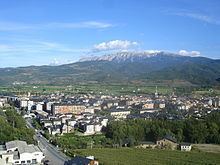Elevation 691 m (2,267 ft) Local time Friday 11:19 AM | Website www.laseu.cat Population 12,366 (2014) | |
 | ||
Demonym(s) Urgellenc, urgellencaor Urgellès, urgellesa Weather 19°C, Wind NW at 2 km/h, 30% Humidity | ||
La Seu d'Urgell ([ɫə ˈsɛw ðurˈʒeʎ], [la ˈsɛw ðuɾˈdʒeʎ]; Spanish: Seo de Urgel, formerly in Catalan: Urgell) is a town located in the Catalan Pyrenees in Spain. La Seu d'Urgell is also the capital of the comarca Alt Urgell, head of the judicial district of la Seu d'Urgell and the seat of Bishop of Urgell, one of the Andorra co-princes. It is in the district of Alt Pirineu i Aran (High Pyrenees and Aran), and is the town with the most inhabitants, having 17.4% of the district population. La Seu d'Urgell and Puigcerdà together have 30% of the population of the area.
Contents
- Map of 25700 La Seu dUrgell Lleida Spain
- Name origins
- Location
- La Seu dUrgell municipality
- Fairs festivals and markets
- Attractions
- Sport
- Demography
- Highest summits
- References
Map of 25700 La Seu d'Urgell, Lleida, Spain
It is located at the confluence of the Segre and the Valira rivers. The city is in the local region of Urgellet, a Pyrenean region formed by 16 municipalities of Alt Urgell. Urgellet and Andorra were the originary County of Urgell with capital in la Seu d'Urgell before the county expansion to the south.
Alt Urgell is the gateway to the state of Andorra and the proximity to this important population center and economic activity is largely one of the reasons for the current drive of the city of la Seu d'Urgell within Alt Pirineu i Aran.
The town's patron saints are Saint Ot of Urgell, Saint Sebastian, and the Virgin of Urgell. While the Virgin of Núria and Sant Ermengol are the main patrons of the diocese of Urgell. Sant Ermengol is the most prominent in the city than other patrons. Probably that's why there are various events throughout the year dedicated to Sant Ermengol, such as the Sant Ermengol Fair, one of the oldest in Catalonia, and the altarpiece of Sant Ermengol.
The Parc Olímpic del Segre, built in 1992 for the Barcelona Summer Olympic Games, is a pump-driven canoe and kayak sports venue located adjacent to the historical centre of la Seu d'Urgell.
Name origins
The name la Seu d'Urgell, in Latin Sedes Urgelli, is formed by two different words: Seu from the Latin "Sedes", or seat, and Urgell a pre-Roman name. Joan Coromines, a linguist, interprets that the name is related to the presence of water.
The Iberian settlement of Arse-durgui (or Arse d'Urgui) was on the hill of Castellciutat. At that time the hill was called Puiolo Urgelli. Where there was the village of Arse-durgui they built the city of Urgell (in Latin civitas Orgellia and in Catalan ciutat d'Urgell) and here lies the origin of the name Castellciutat. Until the eighteenth century the town was known simply as "Ciutat" (City in English) and Castell (Castle) was added because the existence of an ancient castle that was home of the Counts of Urgell.
Shortly after the destruction of the former Orgellia it was created a new neighborhood, new home of the Diocese of Urgell, called vicus Sedes Urgelli denotes that the town is the episcopal see of the Bishop of Urgell.
Over time, Sedes Urgelli took importance and lost the word vicus (denotes that it was a district) while civitas Orgellia lost the word Orgellia and becomes simply Civitas until the 18th century.
Location
The city is at the confluence of two rivers, the Segre and Gran Valira, located in a plain 7 km long and 691 meters high surrounded by high mountains, such as the Cadí mountain range. The plain is called plana de la Seu and was formed by the Segre river.
Because it is located at one of the major crossroads of communication in the Catalan Pyrenees, la Seu d'Urgell has had a unique and historic role in the county of Urgell. The roads to Andorra, Cerdanya and the low Segre all converge on la Seu d'Urgell.
Parallel to the Valira river rises a mountain range, where stand the remains of two great fortresses, the Ciutadella and Ciutat Castle (in Castellciutat), both of historic importance in the town. Small banks or open plains around the Segre are separated by gorges.
In the north, La Seu d'Urgell has borders with the municipality of les Valls de Valira, to the west with Montferrer i Castellbò where there is La Seu d'Urgell Airport (also known as Andorra-Pirineus airport), to the south-west with Ribera d'Urgellet, to the south-east with Alàs i Cerc, and to the north-east with Estamariu.
The municipality includes a small exclave to the east.
La Seu d'Urgell municipality
Fairs, festivals and markets
Despite the low population density of Alt Pirineu i Aran, the area hosts 6.6% of the exhibitions and other civic activities in Catalonia. In la Seu d'Urgell, there are numerous fairs and markets throughout the year:
Attractions
Sport
At its artificial whitewater course, Parc Olímpic del Segre, the town hosted the canoe slalom events for the 1992 Summer Olympics in neighboring Barcelona. It hosted the ICF Canoe Slalom World Championships in 1999 and again in 2009.
Demography
Incorporation of the municipality of les Torres (1857), Castellciutat (1975).
